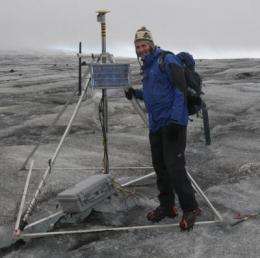Scientists pioneer wireless sensors to explore little known glacier phenomenon

Researchers at the University of Southampton are pioneering the use of wireless sensors to study a little-known phenomenon that affects the movement of glaciers.
Professor Jane Hart from the School of Geography and Dr Kirk Martinez of the School of Electronics and Computer Science (ECS) have been awarded a Leverhulme Trust Research Project Grant to study glacier 'stick-slip' motion as it affects the Skalafellsjökull glacier in Iceland.
According to the team, scientists know surprisingly little about 'stick-slip' motion, the term given to the events which cause ice sheet movement, and occur in the normal course of glacier sliding.
"Due to the logistical problems of studying glaciers and the subglacial environment, we know very little about the process," said Professor Hart. "Until recently, it was assumed that glaciers flowed slowly and continuously, but there is a growing body of evidence that glacier movement can be episodic and can be modelled in a similar way to earthquakes as stick-slip motion."
To measure the 'stick' phase, the researchers plan to use an innovative wireless multisensory probe, which they developed to use on Glacsweb, a project which deployed the world's first wireless probe to measure in-situ processes at the base of a glacier in Briksdalsbreen, Norway.
They plan to use a GPS and accelerometers on the glacier surface to measure the 'slip' phase.
"This research is significant because it uses the most recent technological advances in wireless sensor network research to understand a fundamental property of glacier dynamics," Dr Martinez added. "Environmental Sensor Networks provide a unique way of studying glacial motion and the associated responses of the ice and till. The Glacsweb system is the only glacial wireless system in use today and serves as an ideal platform to investigate new scientific problems."
The project will continue for three years and the data collected will be sent back daily to a server in the UK via the mobile phone network, and published on the web for other researchers.
More information: Recent photos of the area and the process can be found at: envisense.org/glacsweb/photos/iceland2010/
Provided by University of Southampton



















